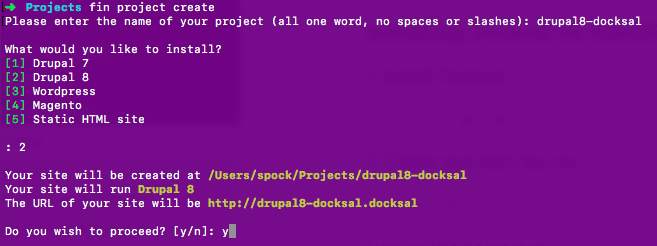- Published on
Drupal 8 with Docker CE and Docksal on macOS
- Authors
- Name
- Christophe Jossart
- Mastodon
- @colorfield
Outdated content
Most content from this article might still be relevant but some sections can be outdated.
We will cover here two options to get started with Docker for Drupal: the Docker Community Edition, then a more straightforward way with Docksal.
Let's have a look at the underlying stack by starting with the bare minimum Docker setup to have a Drupal 8 site running before switching to Docksal.
Option 1: Docker Community Edition (CE)
Install Docker
Get Docker CE for MacOSX, it will run the Docker daemon.
Then check if everything went right.
docker version
Get Drupal 8.x with PostgreSQL
Create a drupal-docker directory and put it this stack.yml file taken from the official Drupal repository on Docker hub.
cd in this directory then
docker swarm init
docker-compose -f stack.yml up
You can then list the running containers
docker ps
Install Drupal
Open http://localhost:8080 in your browser
Complete the database credentials with what is defined in the stack.yml file:
- Database type: PostgreSQL
- Database name: postgres
- Database username: postgres
- Database password: example
- Under advanced options, replace localhost by postgres
Basic Docker commands
List Docker stacks
docker stack ls
Remove a stack
docker stack rm <stack name>
Get a container IP
# get the container id with ps
docker ps
# then inspect the container
docker inspect <container ID>
SSH into a container
docker exec -it <container id e.g. apache> bash
List all containers, even the ones that are not running
docker ps --all
Other Docker basic commands
We will not go on with Docker here, just check the documentation on Drupal.org for a more complete setup with PHPStorm.
Resources
- Drupal.org Docker based development environment
- Docker hub Drupal repository
- Amazee.io Local Drupal Docker Development and Installation of cachalot
- Docker for Mac: Overcoming Slow Mounted Volumes
- Code School Container and images, Docker files and volumes
- Connect your server to Wodby and deploy managed stacks
Option 2: Docksal
https://www.youtube.com/watch?v=jev2EW2hzdY
Docksal uses Docker to create fully containerized environments. It also uses Virtual Box to support MacOS and Windows. Its main feature is the inclusion of a command-line tool, called
fin, that simplifies the management of all components.
Docksal comes preloaded with common Drupal development tools like Drush and Drupal Console, as well as php tools like Composer, PHP Code Sniffer, and php-cli. It also comes with node, npm, ruby, bundler, and python.
Install Docksal
# Get or update Virtualbox then install Docksal
curl -fsSL get.docksal.io | sh
# Create and start the VM
fin vm start
The default directory for your Docksal projects will be ~/Projects
If you are using MacOSX High Sierra, there is a bug with NFS.
Here is how to fix this, this documentation also explains how to switch back to Virtualbox. If you have followed the first installation of Docker CE, just add DOCKER_NATIVE=1 to ~/.docksal/docksal.env, make sure that the Docker daemon is running (start Docker CE) then
fin reset system
If you do not apply this fix, it will cause the following issue while installing Drupal on the next step.
Drupal\Core\Config\UnmetDependenciesException: Configuration objects provided by standard have unmet dependencies
Create a Drupal 8 project
Note that you will have the choice to create a Drupal 7, Drupal 8, Wordpress, Magento or static project.
fin project create
This command will clone the sample Drupal 8 project so it is equivalent to
cd ~/Projects
git clone https://github.com/docksal/drupal8
fin init
Open http://drupal8.docksal in your browser after the setup.
Running docker ps will show the containers behind this setup.
fin commands, to be runned in your project directory
Drupal Console and Drush
fin drupal
fin drush
Database import and dump
fin db import ~/dump.sql
fin db dump ~/dump.sql
List project services
fin status
Recreate project services and containers
fin restart
Stop project services and remove their containers
fin rm
